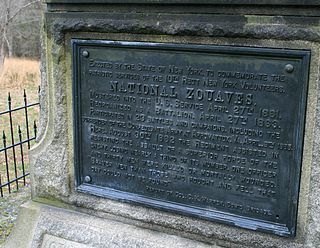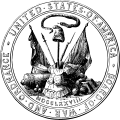
During the American Civil War, the United States Army, the land force that fought to preserve the collective Union of the states, was often referred to as the Union army, the federal army, or the northern army. It proved essential to the restoration and preservation of the United States as a working, viable republic.
The 3rd Wisconsin Cavalry Regiment was a volunteer cavalry regiment that served in the Union Army during the American Civil War.

John Mansfield was an American lawyer and Republican politician. He was the 15th lieutenant governor of California. During the American Civil War, he was a Union Army officer serving in the 2nd Wisconsin Infantry Regiment in the famous Iron Brigade of the Army of the Potomac. He took command of the regiment during the first day of the Battle of Gettysburg and remained in command until the regiment was disbanded in the fall of 1864. After the war, he received an honorary brevet to brigadier general.

The uniforms of the British Army currently exist in twelve categories ranging from ceremonial uniforms to combat dress. Uniforms in the British Army are specific to the regiment to which a soldier belongs. Full dress presents the most differentiation between units, and there are fewer regimental distinctions between ceremonial dress, service dress, barrack dress and combat dress, though a level of regimental distinction runs throughout.

The 69th Pennsylvania Infantry was an infantry regiment in the Union army during the American Civil War.

The 10th Maine Infantry Regiment was mustered in for two years of service at Portland, Maine, on October 4, 1861, by then-Major Seth Eastman. It was mustered out on May 8, 1863, also at Portland. The regimental commander was Colonel George Lafayette Beal. The 10th Maine was a re-organization of the 1st Maine Infantry, a regiment primarily composed of men with two-year enlistments that was mustering out after completing three months of Federal service. Eight companies of the 1st Maine were retained in service, with Companies A and D replaced by newly recruited companies.

The 90th Regiment, Pennsylvania Volunteer Infantry was a volunteer infantry regiment which served in the Union Army during the American Civil War. They wore chasseur-style uniforms, which each consisted of a dark blue habit veste with white trim, baggy sky-blue trousers and a dark blue kepi. The buttons on the habit veste were unique to the 90th Pennsylvania. They were the only Union regiment in the entire war to have a specific button design.

The 5th New York Veteran Infantry Regiment was an Infantry Regiment that served in the Union Army during the American Civil War. The regiment was known as "Duryée‘s Zouaves." The regiment had two uniforms during its time. The first uniform consisted of a medium blue zouave jacket with red trimming, a grey shirt, a red sash with sky blue trimming, red chasseur trousers with yellow piping, a red fez with a yellow tassel, and a white turban. The second and official uniform consisted of a dark blue zouave jacket with red trimmings in the Hawkin Zouave design, a dark blue zouave vest with red trimming, baggy red trousers, a red sash with sky blue trimming,a red fez with a yellow tassel, and a white turban.

The Iron Brigade, also known as The Black Hats, Black Hat Brigade, Iron Brigade of the West, and originally King's Wisconsin Brigade was an infantry brigade in the Union Army of the Potomac during the American Civil War. Although it fought entirely in the Eastern Theater, it was composed of regiments from three Western states that are now within the region of the Midwest. Noted for its excellent discipline, ferocity in battle, and extraordinarily strong morale, the Iron Brigade suffered 1,131 men killed out of 7,257 total enlistments: the highest percentage of loss suffered by any brigade in the United States Army during the war.

The 10th New York Infantry Regiment was an infantry regiment that served in the Union Army during the American Civil War. It was also known as the McChesney Zouaves or National Guard Zouaves.
The military uniforms of the Union Army in the American Civil War were widely varied and, due to limitations on supply of wool and other materials, based on availability and cost of materials. The ideal uniform was prescribed as a dark blue coat with lighter pants, with a black hat. Officer's ranks were denoted with increasing levels of golden decoration. Specific jobs, companies, and units had markedly different styles at times, often following European customs such as that of the Zouaves. Officers uniforms tended to be highly customized and would stray from Army standard. Ironically, several main pieces of gear had been created by order of the U.S. War Secretary Jefferson Davis before the war; he later became Confederate President.
Each branch of the Confederate States armed forces had its own service dress and fatigue uniforms and regulations regarding them during the American Civil War, which lasted from April 12, 1861, until May 1865.

The 114th Regiment, Pennsylvania Volunteer Infantry was an infantry regiment that served in the Union Army during the American Civil War. They were notable for their colorful Americanized version of the Zouave uniform worn in emulation of certain French light-infantry units that became world-famous during France's colonization of North Africa, the Crimean War, and the Second War of Italian Independence fought in the years prior to the American Civil War.
The 29th Maine Infantry Regiment was an infantry regiment that served in the Union Army during the American Civil War.

The 118th New York Infantry Regiment was recruited for service in the American Civil War (1861–1865) from Clinton, Essex, and Warren counties in Northern New York. Known as the Adirondack Regiment, the unit saw service along the Atlantic Coast in the Department of Virginia before transferring to the Army of the James in 1864. With the latter, they were engaged in the Overland Campaign and the subsequent siege of Petersburg.

The 91st Pennsylvania Volunteer Infantry was a Union infantry regiment which fought in multiple key engagements of the American Civil War, including the Battle of Fredericksburg, Battle of Chancellorsville and Battle of Gettysburg. It was established through the combined efforts of Edgar M. Gregory, who had received approval from the U.S. War Department to begin recruiting soldiers for an entirely new regiment during the fall of 1861, and Edward E. Wallace, who had initiated his own recruitment efforts that October. Their recruits were volunteers, the majority of whom initially enlisted for three-year terms of service from their hometown of Philadelphia; they were divided into 10 lettered companies upon muster in during early December 1861: A, B, C, D, E, F, G, H, I, and K.

The 80th New York Infantry Regiment, originally designated the 20th New York State Militia Regiment, "Ulster Guard", was an infantry regiment of the Union Army during the American Civil War.
The 1st Delaware Cavalry Battalion was a cavalry regiment of the Union Army in the American Civil War. Raised in late 1862, the 1st Delaware Cavalry Battalion was initially to be raised as the 1st Delaware Cavalry Regiment, but was reduced to a battalion due to the inability of the state to fill a cavalry regiment to full strength. It served on provost duty in Maryland and Delaware from 1863 to early 1864, and fought in the action at Westminster known as Corbit's Charge during the Gettysburg Campaign. It participated in the Overland Campaign in June 1864, then returned to Maryland after the Confederate cavalry raid of Jubal Early. It remained there for the remainder of the war, and was mustered out after its end.

The Corps of Invalids was a British unit that provided garrison troops for the defence of England and Great Britain between 1688 and 1802. The men and officers were all veterans of the British Army chosen by the commissioners of the Royal Hospital Chelsea to serve in lieu of a place at the hospital or receipt of a pension. The corps was rapidly expanded or decreased in size as needs arose and played a key role in regulating the manpower requirements of the British Army. The corps was organised into a number of independent companies that were garrisoned at key points in the country, freeing up units of the regular army for service overseas. The men were generally those who were too old or wounded to serve in the regular forces and most served at least six years with the corps. In the early years they wore a grey uniform but later wore the same red coat with blue facings as worn by the patients of the Chelsea Hospital.
On June 12, 1851, the United States Army issued new uniform regulations. The new regulations set out a system of chevrons to show enlisted rank.














